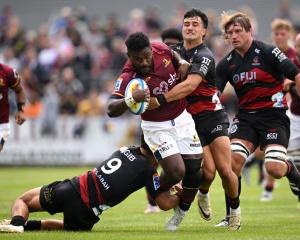After the All Blacks' big win over the USA in Chicago yesterday, ODT Online rugby writer Jeff Cheshire looks at five key points from the game.
Inaccurate second half
The All Blacks looked pretty good for 40 minutes. Their passes stuck, they ran good lines and the defence held despite having to tackle for 20 phases at one point. But the second half saw the game go into a lull. Sometimes it can be hard to come out firing after such a dominant first half. It was not as if they were not creating chances though, it was just that they were not finishing them. Too many dropped balls, poor passes, shoddy lineouts. It really did not help and let the USA off the hook a number of times. While in a 70-point massacre it does not have quite the same bearing, in a close game where chances are few, these errors can be the difference between a win and a loss. We saw it a few weeks ago in South Africa. The All Blacks need to make sure they do not make it a habit.
Goal kicking
Everyone saw this so we will not go into great depth on it here, other than to give it a mention. It was not just that Aaron Cruden missed five of his nine shots at goal that was a problem, it was that he was not even getting close with some of them. He did not seem to be striking the ball well. Often his kicks lacked direction, or distance, and while they were not easy shots, they never looked like going over. In a close game every point counts and you cannot afford miss that many kicks that badly.
Sonny Bill needs to do it against better opposition
Even his harshest critics could not deny Sonny Bill Williams had a strong return to the All Blacks. He ran good lines, hitting the ball at pace and running well at gaps. Perhaps even more encouraging was his defence, where he got involved and showed the ability to tackle low around the legs, as well as high to wrap up the ball. However, it was not a surprise. In his last stint in rugby union, Williams did play well against these sorts of teams.
It was when he had to do it against a tougher opponent that he would go into a shell. Against second-rate teams he would look a million bucks, running hard at the line, offloading well and coping alright on defence. When it came to a tougher team though, such as South Africa, he seemed to go missing. He would stop taking the ball to the line, just looking to shovel it on. If he is not making mistakes then that it okay, but most second five-eighths in New Zealand could be doing that too. He needs to show against quality opposition that he is going to bring something that others cannot. If not, it will be hard justifying his selection when there are four other quality midfielders in New Zealand right now.
USA - The good
The best that could be said about the USA was that their ball retention was good. When they had the ball, the All Blacks did not, which meant the All Blacks could not score. And that pretty much sums up how it went. Despite holding onto possession for a couple of long stretches - one sequence lasted over 20 phases - the USA never actually looked like breaking the line. They were too lateral on attack, throwing the ball from side-to-side and making it easy for the All Blacks to get up and cut them down. There was no punch, no direction, nothing to give the defence anything to worry about.
In fact, it was not too dissimilar to Otago's attack in the ITM Cup this year. Perhaps this may even be giving the USA too much credit. It was not as if the All Blacks were contesting the breakdown all that ferociously and when they did go in, they usually won a turnover.
USA - The bad
It is hard to be too critical; it was always going to a tough task for the USA. In reality these two teams were at two different levels and it showed, especially on defence. While the All Blacks' line remained intact for the entirety of the game and rarely looked under pressure, the USA defence struggled to stay organized when the All Blacks launched an attack. Out wide they continually got lost and the quality of the All Blacks' support play meant that they were punished for their errors. Their scrum was an issue, although Craig Joubert seemed to be making a point of limiting the time spent at set-piece - probably a good thing too.
The All Blacks were playing at a pace this team was clearly not used to and this as much as anything was what they struggled with. When the pace of the game increases, you have less time to make decisions and execute skills which you may normally be able to do just fine. Having a second or two less can make all the difference, particularly on defence where you have less leeway in being caught out of position. The All Blacks exposed this and they capitalised on it. But the USA, and others, will never get better if they do not play against these sorts of teams. So we need to continue with it, even if in the short-term it seems like a non-event.













